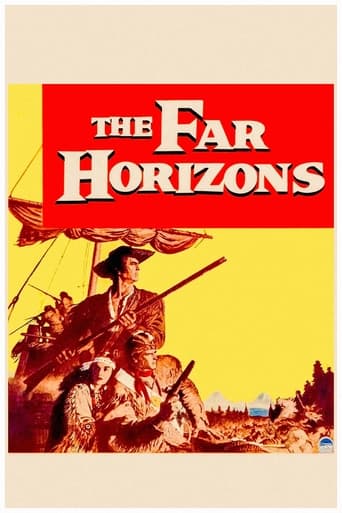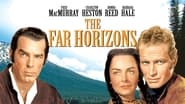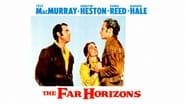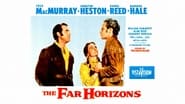jjnxn-1
For what it is, an almost total fabrication of the events involved in the exploration of the Louisiana territory, the film is an enjoyable, beautifully shot adventure but for the real story look elsewhere. Donna Reed is ridiculously cast as Sacajawea, Katy Jurado who was actively working in Hollywood at the time would have been far more suitable. She gives an earnest reading of the part but if this is the best the studios could find for her after her Oscar win it's little wonder that she had moved over to TV within a few years. MacMurray although first billed actually disappears for several stretches of the film and Heston, who is ideal in this sort of picture, carries the bulk of the movie.
Wayne Dear
See this movie for the first time on TCM for a primer on Hollywood studio film making in the post-war '50s. Get The Journals of Lewis and Clark edited by Bernard DeVoto for the best story you will ever read about the discovery of the American West, and it's all true. The book is in libraries and at Amizon.com. Second choice: Undaunted Courage by Stephen Ambrose.The stars of the movie (Fred MacMurray, Charlton Heston, Donna Reed) are Hollywood legends but their acting is as uninspired as the script. William Demarest as Sgt. Gass is the only believable character. The combat scenes are total fiction. Only one member of the Corps of Discovery died (of an illness)and only one Indian was shot, for trying to steal a horse from Lewis one night in Monatana on the return trip.As others have reported, the love story is contrived but remains a fascination in Western romance novels about Sacajawea. The joke is on the film makers because The Journals ooze sex between the men of the Corps and women of some of the tribes. Lewis was the medic and half of his medicine it seems was used to treat the men suffering from venereal diseases.Read the book; maybe someday Hollywood will make the movie.Note to reviewers: Use of the term "squaw" has been politically incorrect for some time.
kterryl
Many reviewers on this site, and the daytime host of Turner Classic Movies have said, this is the only Hollywood movie that has been made about the Lewis and Clark expedition. They have all been misinformed. This film is so lacking in historical accuracy that I am surprised the heirs of Lewis and Clark (perhaps there aren't any) have not sued the producers for slander. Nothing except the heroism of Sacajawea and the general route of the expedition are portrayed even remotely realistically. Many reviewers have pointed out errors; I will just add a few more: No one in Washington knew there were mountains between the source of the Missouri River and rivers flowing to the Pacific (Jefferson thought an all water route could be developed), the only serious Indian difficulties were met with the Blackfeet, Birchbark canoes were strictly a Chippewa product and western tribes mostly used the much more rugged dugout canoes as they had a ready supply of very large tree trunks for raw material (Idaho, between the Missouri and Columbia Rivers is still a lumber supplying country today), very few Americans knew what a buffalo was in 1806, Judith, not Julia, had her name immortalized in Montana natural features, the explorers were sending back to Jefferson reports and specimens along the way as they proceeded west but it took some time to get a finished narrative to him and some of the crewmen got their reports published before Clark's (Lewis never did finish his). And of course, most notably, Sacajawea was firmly in the familial arms of her French fur trader husband (who was a skunk) for all or most of the trip, even having a son by him on the trail; and it was very unlikely that William Clark had any romantic interest in her. She was a teen ager at the time, and I thought the 34 year old Donna Reed did a good job of playing a teen aged Indian girl, even if no one else did. Also, there actually was an incident when a boat (actually 2 boats) was pulled up around a portage on rollers on track. So we are still waiting for the movie, but there has been some non-fiction work done that is pretty good, entertaining and worth watching.
alexandre michel liberman (tmwest)
If I would have seen the trailer (preview) of this film in the fifties I would probably not have missed it. It had everything to please , the colorful scenes on the river, the great scenery and potentially a great story about Lewis and Clark that wanted to get to the Pacific and faced all kinds of dangers. It had a lot in common with 'The Big Sky' with the advantage of being in color. But 'The Big Sky' was quite a film and 'The Far Horizons' failed. By casting Donna Reed as an Indian woman and making her character so important they went wrong. Reed is a good actress, but this part was not for her. Just comparing her with the Indian girl in 'The Big Sky' we realize why. It is not really her fault, but her character was too much of a cliché. SPOILER AHEAD. I thought the great moment of the film would be when they start seeing the Pacific Ocean. I kept thinking of 'Lawrence of Arabia', that spectacular moment when Peter O'Toole is walking in what seems like an endless desert and suddenly sees the Suez Canal. But in this film, who knows why, probably because they went over budget, this is not shown. The film cuts abruptly to when they are already in the Pacific, celebrating their achievement. Quite a letdown.






